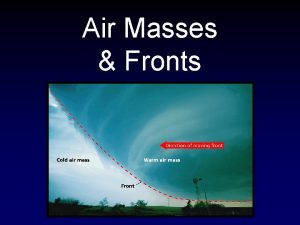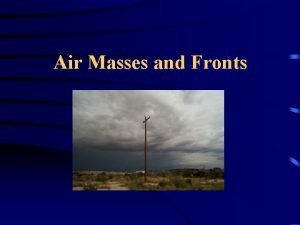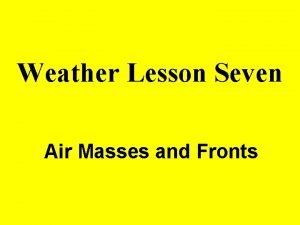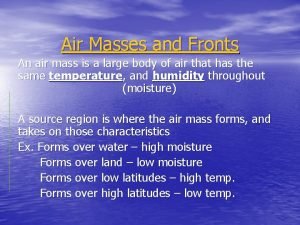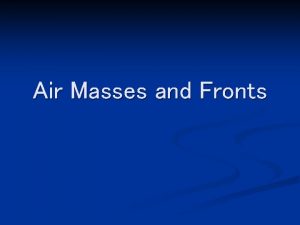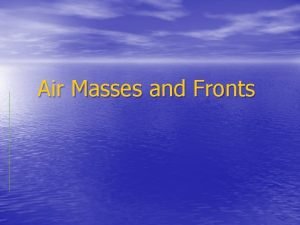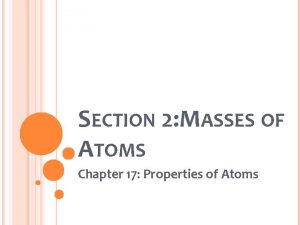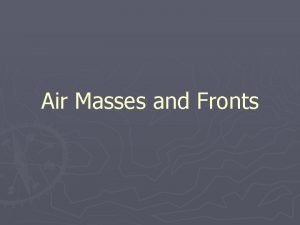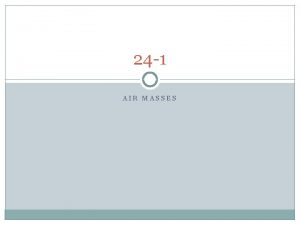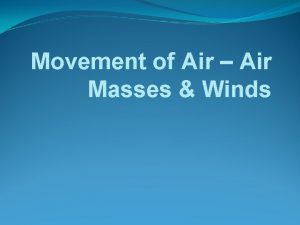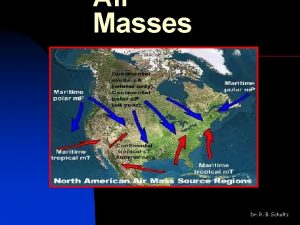Air Masses Chapter 20 Section 1 Air Masses











- Slides: 11

Air Masses Chapter 20, Section 1

Air Masses and Weather Air Mass – immense body of air that is characterized by similar temperatures and amounts of moisture at any given altitude l Because of its size, it may take several days for an air mass to move over an area (giving that area fairly constant weather) l When an air mass moves out of the region over which it formed, it carries its temperature and moisture conditions with it l As it moves, the characteristics of an air mass change, and so does the weather in the area over which the air mass moves l

Influence of a Canadian Air Mass

Classifying Air Masses l l l The area over which an air mass gets its characteristic properties of temperature and moisture is called its source region Air masses are named according to their source region Polar (P) air masses (cold air) form at high latitudes, while tropical (T) air masses (warm air) form at low latitudes In addition to their overall temperature, air masses are classified according to the surface over which they form Continental (c) form over land (dry air) and maritime (m) form over water (humid air) The four basic types of air masses in North America: Continental Polar (c. P) – cold and dry Continental Tropical (c. T) – warm and dry Maritime Polar (m. P) – cold and moist Maritime Tropical (m. T) – warm and moist

Air Mass Source Regions

Weather in North America l l l Much of the weather in North America, especially weather east of the Rocky Mountains, is influenced by continental polar (c. P) and maritime tropical (m. T) air masses Continental polar air masses are uniformly cold and dry in winter and cool and dry in summer; lake-effect snow is caused when one of these air masses passes over the moisture of the lake and drops the precipitation down on the leeward side of the lake Maritime tropical air masses are warm, loaded with moisture, and usually unstable; they are the source of much of the precipitation in the eastern two thirds of the U. S. During the winter, maritime polar (m. P) masses that affect weather in North America come from the North Pacific Continental tropical air masses have the least influence on the weather of North America Only occasionally do continental tropical (c. T) air masses affect the weather outside their source region




Continental Polar and Maritime Polar Air Masses

Assignment l Read Chapter 20, Section 1 (pg. 558 -563) l Do Section 20. 1 Assessment #1 -5 (pg. 563)
 Two cold air masses converge on a warm air mass
Two cold air masses converge on a warm air mass Maritime polar
Maritime polar Air masses & frontswhat is an air mass?
Air masses & frontswhat is an air mass? What are the seven
What are the seven Air mass vocabulary
Air mass vocabulary Air masses & frontswhat is an air mass?
Air masses & frontswhat is an air mass? Air masses & frontswhat is an air mass?
Air masses & frontswhat is an air mass? Air masses & frontswhat is an air mass?
Air masses & frontswhat is an air mass? Chapter 12 section 1
Chapter 12 section 1 Chapter 12 air section 1 what causes air pollution
Chapter 12 air section 1 what causes air pollution Section 2 masses of atoms
Section 2 masses of atoms Air masses in north america
Air masses in north america

